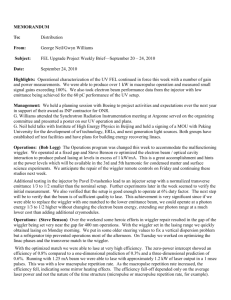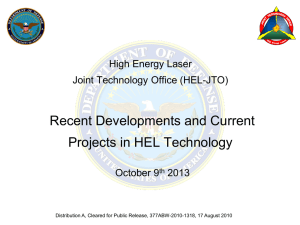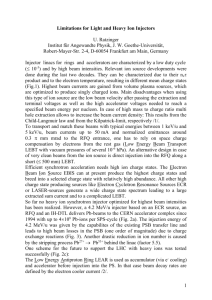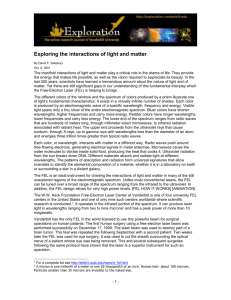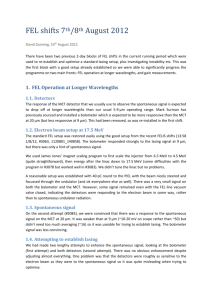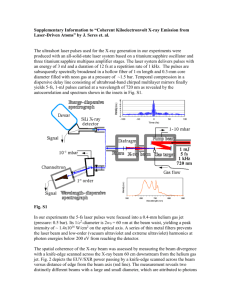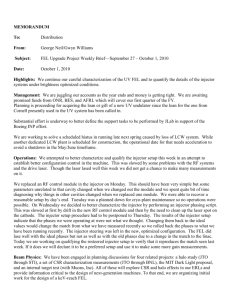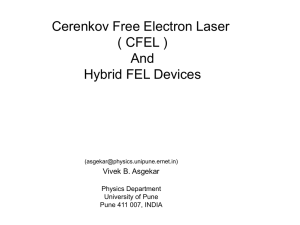NGLS Design Study and Accelerator R&D
advertisement
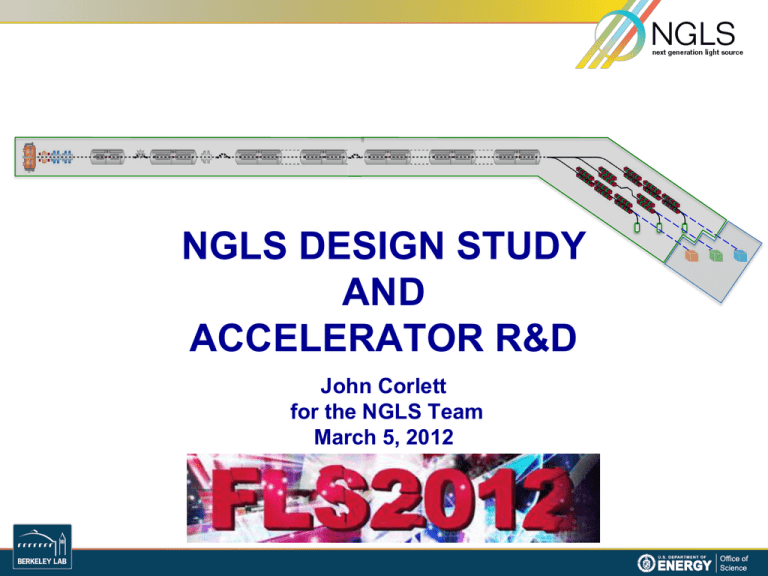
NGLS DESIGN STUDY AND ACCELERATOR R&D John Corlett for the NGLS Team March 5, 2012 1 Motivation Coherent X-rays with high repetition rate, unprecedented average brightness, and ultrafast pulses Today’s storage ring x-ray sources Weak pulses at high rep rate ~ nanoseconds ~nanojoule Today’s x-ray laser sources ~ milliseconds … Tomorrow’s x-ray laser sources ~millijoule ~0.1 millijoule 2 ~ picoseconds ~ microseconds Intense pulses at low rep rate … ~ femtoseconds Intense pulses at high rep rate ~ attoseconds to femtoseconds Approach High average power electron beam distributed to an array of FELs from high reprate injector and CW SCRF linac Beam spreader High-brightness, CW superconducting linac, high rep-rate gun laser heater, bunch compressor and injector Array of independent FELs X-ray beamlines and endstations 3 Capabilities High repetition rate soft X-ray laser array o Up to 106 pulses per second o Average coherent power up to ~100 W Spatially and temporally coherent X-rays (seeded) o Ultrashort pulses from 250 as – 250 fs o Narrow energy bandwidth to 50 meV • Tunable X-rays o Adjustable photon energy from 280 eV – 1.2 keV • − higher energies in the 3rd and 5th harmonics o Polarization control • o Moderate to high flux with 108 – 1012 photons/pulse Expandable o Capability o Capacity 4 More photons per unit bandwidth More photons per second Shorter pulses • Controlled trade-off between time and energy resolution Science requirements drive machine design • Tuning range • Pulse duration • Maximum photon energy • Bandwidth • Peak flux • Stability • Average Flux • Synchronization • Repetition rate • Contrast ratio • Two-color capability 5 • Accuracy Accelerator Systems R&D priorities • High repetition rate – Injector “APEX” – Beam spreader • Advanced FEL operation – Modeling and optimization – Seeding approaches – Seed lasers – Superconducting undulators 6 Developing partnerships • SCRF • RF power APEX gun: high-brightness MHz electron source • APEX cavity is successfully RF conditioned 7 APEX in the Beam Test Facility 8 APEX Activity and Plans Yb fiber F. Sannibalephotocathode drive laser • 1 MHz reprate Yb fiber laser • LLNL/UCB/LBNL collaboration 9 Photocathode materials R&D K2CsSb: 6% QE at 532 nm 0.36 microns / mm rms en >> 1 week lifetime 4 x 10 3.5 100 3 200 2.5 300 400 2 500 1.5 600 700 1 800 0.5 900 1000 High QE 10 Good lifetime at 10-9 mBar 200 400 600 800 1000 0 Low transverse momentum APEX stages Phase I: Beam characterization at gun energy (750 keV) Phase-II: Beam characterization at 15–30 MeV • 6-D brightness measurements Phase 0: Gun and photocathode tests Diagnostics systems in collaboration with Cornell CLASSSE Accelerating cavities in collaboration with ANL AWA • Planning for final installation in 2013 11 Optimizing the beam spreader Electrostatic septum Kicker (0.6 mrad – was 3 mrad) • • 12 Magnetic Septum DC Bends Electrostatic allows 5x weaker kickers (1/5 stability tolerance) Footprint reduced ~1/3 Optimizing the beam spreader Electrostatic Septum 2.0 m, 9.6 mrad Magnetic Septum 1 m, 45 mrad Pulsed Kicker 1 m, 0.6 mrad x z Linac line D F D D • • 13 Electrostatic allows 5x weaker kickers (1/5 stability tolerance) Footprint reduced ~1/3 Linac developments – “10/25/11” layout CM1 GUN 1 MeV Accelerating cryomodules Linearizer cryomodules Laser Injector heater CM2 HL Spreader CM3 CM9 Accelerating cryomodules Bunch compressor 1 Bunch compressor 2 Heater 70 MeV BC1 168 MeV BC2 640 MeV ~670 m 14 CM10 CM30 SPRDR 2.4 GeV Buncher Injector optimization Gun RMS bunch length (mm) Pareto front of genetic optimization • 300 pC, ~70 MeV design point • Delivers required beam brightness 1 keV Projected normalized emittance (m-rad, 100%) 15 RMS energy spread 5 keV Beam dynamics modeling through •linac Two-stage compression Longitudinal beam phase-space • 2.4 GeV at entrance of FEL beamlines* – APEX-gun generated beams (300pC) – ≥ 600 A peak current and small residual energy chirp within usable beam core – limited CSR-induced projected emittance growth Twiss functions through the Linac Current profile *’Elegant’ simulation through the linac starting from an ASTRA-simulated beam out of the APEX-gun based injector 16 Self-seeded FELs e- chicane 1st undulator 2nd undulator with taper SASE FEL SASE FEL spectrum Single crystal: C(400) ~ 20 eV Self-seeded FEL Seeded FEL spectrum ~ 0.5 eV Near Fourier Transform limit Initial results: 40x reduction in BW (40x increase in peak brightness) LCLS Soft X-ray Self Seeding – in planning stages 17 Laser seeded FEL – ”ECHO” • Developing R&D plans • Beam experiments • Laser developments 18 EEHG HHG HGHG HHG seeded FEL R&D • HHG seeding at ~50–100 eV • HGHG to reach 1.2 keV 1 kHz, 40 mJ, HHG source for seeding R&D 19 FEL harmonics measurements at LCLS • Now using filters Daniel Ratner • Fit to detected signal level with attenuators I » I 0 ( f1e- l1P1 + f3e- l3P3 + f5e- l5P5 +...) • Future using spectroscopic fast CCD detector • LBNL detector 20 Superconducting undulator R&D Planar Nb3Sn undulator HTS tape undulator 21 Cryostat for test and measurement Summary • DOE has approved Mission Need for a Next Generation Light Source • LBNL led the effort • We are: • Developing science case and experimental requirements • Evolving machine design to best meet science needs • Executing and developing R&D plans • Strengthening and building collaborations 22
